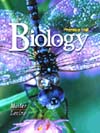Biology News from millerandlevine.com
To best understand the material in this web article, read the sections in our textbook that explain how the immune system works. (Dragonfly book Sections 40-1 and 40-2; Elephant book sections 45-1 and 45-2.)
Sometimes, the data available to the Vaccine Advisory Committee are accurate, and provide clear choices for selecting the "right" three strains to include in the vaccine. More often, those data are extremely complex and puzzling. Still, the panel manages to make many accurate decisions, so the vaccine they recommend offers good protection from the most serious and common flu strains the following year. Given the complexity of the data, and the amount of uncertainty about which strains will spread, the panel's success rate is remarkably high. But of course, when a vaccine works as people expect it to, that success is generally taken for granted.
Sometimes, the data are either so contradictory or so confusing that even the best and brightest infectious disease specialists in the country can't find three clear "winners." When this happens, the panel must make what amount to highly educated guesses. Sometimes they guess right and sometimes they don't. As a result, some years, the recommended vaccines offer little or no protection against the most serious strain (or strains) in U.S. And, of course, given the way the media and the public think, it is these occasional "goofs" that people pay most attention to!)
Still other times, the "right" choices for the vaccine may be clear, but practical difficulties complicate the panel's decision. That was the case for the 2003-2004 flu season. Here's what happened.
Data gathered for the 2003-2004 season vaccine identified a strain from China called the Fujian strain after the region from which it was first reported. This strain looked dangerous. It was a member of the Influenza Type A H3N2 class of viruses, which often cause severe illness and death. It had hit Japan and Korea in 2002, and cause the largest outbreak in Australia in five years.
Unfortunately, vaccine manufacturers experienced major problems with this strain. They couldn't get it to grow in eggs, and were worried that they wouldn't be able to produce enough of it to include in the vaccine. Most committee members agreed that an alternative way of growing this strain (in a culture of dog cells) posed significant risks. So they were faced with a very difficult choice.
They could recommend that the Fujian strain be included in the vaccine — knowing that difficulties in producing it could mean that there would be no vaccine available at all.
On the other hand, they could recommend making the vaccine with a close relative, known as the Panama strain. That strain could be produced reliably, and it seems similar enough to the Fujian strain to offer at least some protection.
This was a very difficult position. The committee delayed a decision as long as possible — until March. But manufacturers still couldnšt grow the Fujian strain quickly enough. When the committee finally had to decide, 17 out of 18 members voted to recommend the Panama strain. Most of them were distressed about that forced decision.
As it turned out, their distress was justified.

The decision about
which flu strains to include in the vaccine each year is extremely difficult
to make.
Index of this Web Article:
• Introduction — What's up with the Flu?
• What is influenza — and who gets it?
• Why can we get the flu again and again? And why can't we develop a one-time flu vaccine?
• How are flu vaccines made?
• Why are flu vaccines sometimes not effective?
• Why are researchers so worried about this new bird flu?
